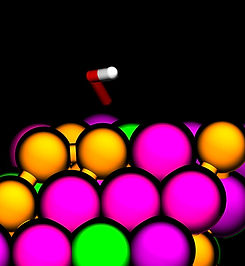THE COMPUTATIONAL NANOMATERIALS LABORATORY

Our research lies at the intersection of engineering mechanics, computational chemistry, and statistical physics. Our tools are multiscale physics-based simulations and data-driven approaches which we use to study and understand the composition-structure-property relations in a wide variety of materials with diverse applications.
Among other topics, we are currently working on the rational design of high-entropy alloys (HEA) for electrocatalysis, the multiscale reactivity of silicate glasses for sustainable infrastructure, the mechanics of disordered solids and glasses, and the biomechanics of growing bacterial biofilms, which are ubiquitous in nature.
Multiscale reactivity of silicate glasses for sustainable concrete

Supplementary cementitious materials (SCMs) can undergo hydraulic or pozzolanic reactions and thus have the potential to partially replace Portland cement (the infrastructure material with the highest CO2 footprint) in concrete mixtures. Whether waste materials, industrial by-products, or calcined clays, SCMs display structural and chemical heterogeneity. Our current understanding of how SCMs react, and how that reactivity depends on their chemical composition and multiscale structure is woefully incomplete, which ultimately limits our ability to discover or design new, better SCM formulations.
In this project, we are using different simulation techniques across a broad range of time and length scales to simulate, understand, and predict the dissolution kinetics of complex silicate glasses. Using ab initio molecular dynamics (AIMD) and Metadynamics, we are investigating the mechanisms and free energy barriers to dissolution of Si and Al in calcium aluminosilicate (CAS) glasses, the main reactive phases of most SCMs. We are using classical and reactive molecular dynamics (MD) to investigate the composition-structure relationship in CAS glasses, with particular emphasis on the characterization of the medium range order and the topology of the silicate and aluminate network. Finally, we are using kinetic Monte Carlo (KMC) to upscale our molecular understanding and study the effect of mesoscale heterogeneity on the dissolution kinetics of SCM particles at time scales relevant to dissolution experiments.
This project is being conducted in collaboration with Dr. Prannoy Suraneni at the University of Miami, and it is sponsored by the Engineering for Civil Infrastructure (ECI) program, in the Division of Civil, Mechanical & Manufacturing Innovation (CMMI) of the National Science Foundation (NSF).
Rational design of high-entropy alloys for electrocatalysis

Catalytic performance can be inferred from the adsorption energy of the reaction intermediates to the surface of the catalyst, which can be calculated using DFT simulations. Conventional metal catalysts are made of one or two constituent elements and thus contain a reduced number of binding sites on the surface. This makes single-element and binary alloy catalysts amenable to computation but hardly tunable. HEAs are compounds made of multiple metallic elements, typically more than four, which are stabilized in a single-phase solid solution by the entropy of mixing of the components. The large compositional space and the myriad of binding environments present on the surface confers HEAs with practically limitless tunability. However, because conventional computational tools (or experiments) are not suited to screen the vast design space of HEAs, rational design strategies are desperately needed.
In this project we are combining DFT adsorption energy calculations with machine learning regression models to predict the distribution of adsorption energies of oxygen intermediates on HEA surfaces made of earth abundant metals, which are inexpensive and non-toxic, and thus ideal for electrochemical treatment of wastewater. Oxygen intermediates are not only involved in the production of oxidants for wastewater treatment applications, but also in numerous other technological processes including oxygen reduction and oxygen evolution reactions. Characterizing the distribution of adsorption energies of different reaction intermediates given a HEA composition, is a first step in the rational design and optimization of HEAs for electrocatalysis.
Mechanics of disordered solids and glasses

Glasses and disordered solids exist across a broad range of length scales, from atoms (e.g., silicate glasses) to colloids (e.g., cement hydrates) to macroscopic particles (e.g., sand piles). In contrast to crystalline materials, disordered solids lack long-range translational and orientational order. This lack of lattice periodicity makes it challenging to establish structure-property relations or to even identify structural defects. In fact, conventional structural descriptors have been shown to correlate poorly with the properties of glasses.
In this project we are using machine learning methods to decode the relationship between the static structure of the glass and its corresponding mechanical response. We are generating training data using molecular dynamics (MD) simulations of glasses under stress. As a first step, we are trying to predict the displacement of individual particles in a Kob-Andersen glass under stress based only on their local structural environment. Ultimately, our aim is to predict the creep response of the colloidal glasses that confer strength to concrete, such as calcium-silicate-hydrates (C-S-H), and to identify colloidal architectures that are resistant to creep.
Biomechanics of bacterial biofilms

Bacterial biofilms—earth’s most ubiquitous life form—have successfully colonized hostile environments as diverse as hot springs, plant roots, or prosthetic implants impregnated with antibiotics. The phenotypic and morphological heterogeneity of biofilms have been hypothesized to be responsible for this extreme resilience. However, the underlying mechanisms remain unknown.
In this project, we are developing a computational model of biofilm morphogenesis that captures the coupling between the main biological functions of bacteria, including the phenotypic expression, to their realistic mechanical response. Our model will reproduce phenotypic and morphological heterogeneity as an emergent response of a developing biofilm. Using our model, we will elucidate the role of phenotypic plasticity and biofilm wrinkling on the survival of biofilms in fluctuating, hostile environments.